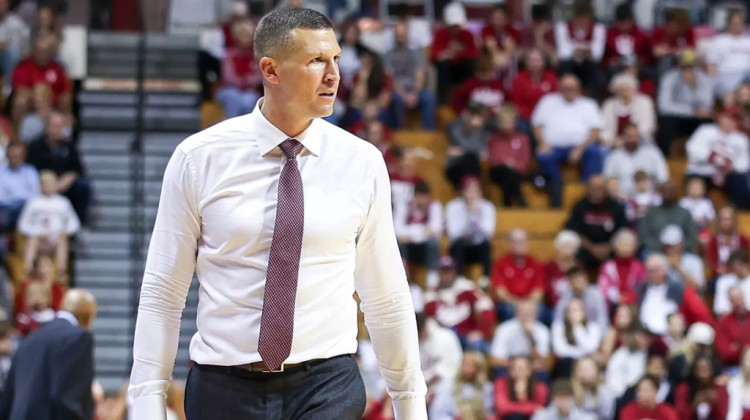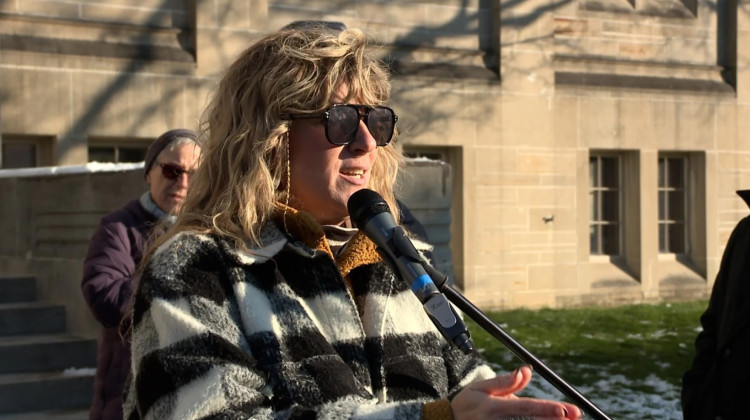
Indianapolis Lighthouse East, a far east side charter school that includes grades 7-12, will close in June, its board decided.
Shaina Cavazos/ChalkbeatA far east side charter school that suffered from dwindling enrollment, low test scores, and high teacher and principal turnover will close in June.
Indianapolis Lighthouse East, which reopened four years ago, was expected to graduate only 44 percent of seniors in its first graduating class this year. The school, which includes grades 7-12, also anticipated a budget deficit and fewer students next year, and teachers and students alike have complained that discipline is a major issue there.
“It’s, frankly, a sad occasion for us to close that school, because we have many dedicated staff who have worked day in and day out to try and create good outcomes for students,” said Adam Collins, chairman of the school’s board, which voted Thursday to shut it down. “But we just didn’t have the resources and the enrollment and the ability to be successful.”
Meetings have been scheduled for parents of the school’s 308 students to discuss next steps, and a website for them has been set up. Additionally, there are plans to ensure students have a school next year with help from the mayor’s office and Enroll Indy, which provides enrollment assistance in Indianapolis.
In voting to close the school, the board cited a string of problems, some of which emerged in a damning review conducted in December by an external evaluator based on standards set by the Indianapolis Mayor’s Office, which is responsible for overseeing the school. Patrick McAlister, director of the Office of Education Innovation, said Indianapolis Lighthouse East had clear challenges.
“The school had a number of issues related to staffing, special education, and a variety of different issues,” McAlister said. “The most important thing will be to ensure that every kid finds a good option.”
The school had cycled through three principals in four years and saw other administrators leave. It was billed as having an “arts-infused” curriculum, but teachers said the school showed no signs of living up to that designation. Along with high staff turnover more broadly, the school didn’t have a college and career advising leader at the time of the review.
Lighthouse East has been under-enrolled since it opened four years ago, according to a presentation given to the board, and only 274 students were expected to return next year. With so few students, the school was projecting a budget deficit of more than $600,000 for the 2019-20 year.
Student test scores were far below state averages. Just 2.7 percent of high schoolers passed the state math exam, and about 18 percent passed English. Although the school received a B grade from the state in 2018, that’s based only on student test score improvement or “growth,” which is a controversial measurement available to new schools and innovation schools that lawmakers are looking to get rid of this year.
The school’s sub-par academics may be explained, in part, by persistent struggles hiring and retaining teachers. The mayor’s office review said 12 teachers had left just this year, and there were vacancies in several subjects, most critically in science and Spanish. Many teachers were not licensed, which the state allows for charter schools, and teachers and subs reported a lack of training on the school’s curriculum. For some core subjects, the school was relying on long-term substitute teachers, and even administrators, in some cases.
The atmosphere wasn’t conducive for learning, according to the mayor’s review, in part because of a restorative justice model of discipline that students and teachers said wasn’t working. Students weren’t punished for disobeying rules, giving them no incentive to behave, the review concluded.
Most teachers offered that the restorative justice model, although having good intentions, is not executed well at the school and, therefore, led students to conclude there are no consequences for their poor behavior. One group of teachers even noted, “Our restorative justice approach is the number one threat to the culture of our school.” Students also scoffed at the discipline approach. One student exclaimed, “This is the first school I have attended where you can be involved in a major fight one day, and back at school the next day.”
On top of these issues, four students had died in incidents outside of school, meaning the school community was dealing with extra trauma.
Lighthouse East has had a rocky history in Indianapolis. It first opened in 2010. In 2013, the school, then known as Monument Lighthouse, also closed, and its board cited many of the same reasons that Collins mentioned Thursday as the current school. The school reopened with a new charter in 2015 as Indianapolis Lighthouse East. The board presentation said the school was invited by the mayor’s office to create a new charter high school based on the success of its sister school, Indianapolis Lighthouse South, and a dearth of high school options on the far east side.
The south campus, which opened in 2009, will remain open, as will Circle City Prep, a separate charter school that shares Lighthouse East’s building. The east and south campuses are part of the national Lighthouse Academies charter school network, which also has schools in other parts of Indiana and other states.
Lighthouse East is the second charter school to have news of closing this week — Indianapolis Academy of Excellence did not have its charter renewed by its authorizer on Tuesday, making it likely it will also close at year’s end.
Collins said the board felt it was making a responsible decision to close given the results they were seeing.
“For more than a year, we’ve been working with our national management organization to try to work to improve,” Collins said. “At the end of the day, given the report we had from the mayor’s office related to our performance across its measurement metrics, we didn’t feel that we would be able to provide students with a better education option than what currently exists in other places.”
Chalkbeat is a nonprofit news site covering educational change in public schools.
 DONATE
DONATE







 Support WFYI. We can't do it without you.
Support WFYI. We can't do it without you.